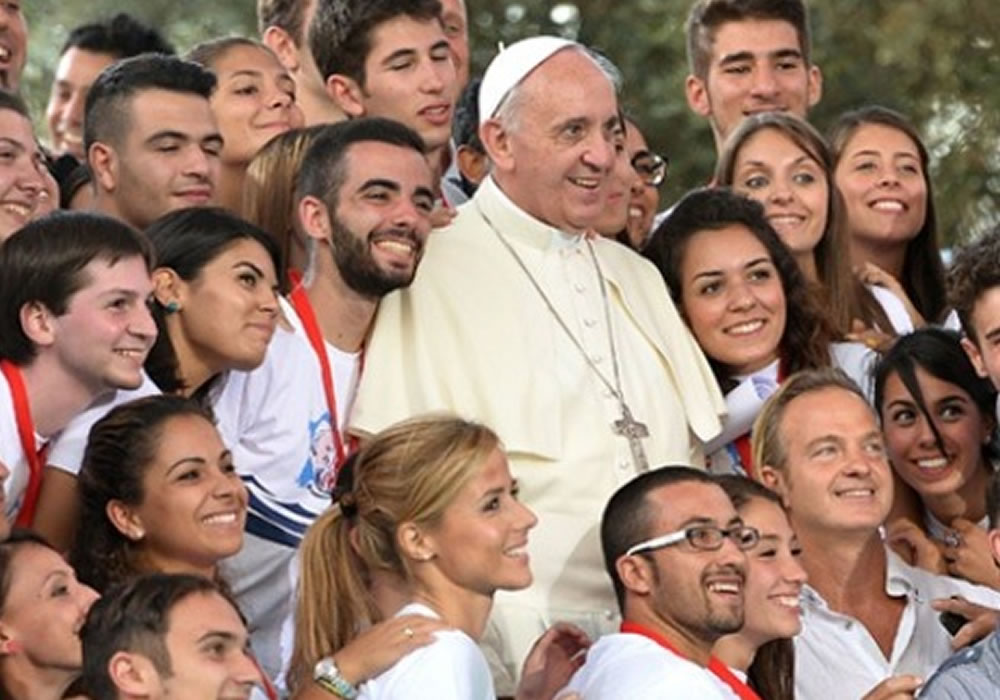(ZENIT News / Vatican City, 12.09.2022).- The 38th World Youth Day will be held on November 2o0, 2022 in all the dioceses of the world and, a few months after, the World Youth Day in Lisbon, Portugal will be held from August 1-6. As preparation for both events, the Holy Father sent a message that pivots around the word arise. It’s the third message that pivots around this theme and that finalizes the series.
Here is a translation of the message with headers in bold by ZENIT.
* * *
“Mary arose and went with haste” (Lk 1:39)
Dear Young People!
[1st God’s urgent invitation to arise]
The theme of the Panama World Youth Day was, “I am the servant of the Lord. May it be done to me according to your word” (Lk 1:38). After that event, we resumed our journey towards a new destination – Lisbon 2023 – with hearts afire with God’s urgent summons to arise. In 2020, we meditated on Jesus’s words: “Young man, I say to you, arise!” (Lk 7:14). Last year too, we were inspired by the figure of the Apostle Paul, to whom the Risen Lord said: “Arise! I appoint you as a witness of what you have seen” (cf. Acts 26:16). Along the route we still need to travel before arriving in Lisbon, we will have at our side the Virgin of Nazareth who, immediately after the Annunciation, “arose and went with haste” (Lk 1:39). Common to these three themes is the word: “arise!” It is a word that also – let us remember – speaks to us of getting up from our slumber, waking up to the life all around us.
In these troubling times, when our human family, already tested by the trauma of the pandemic, is racked by the tragedy of war, Mary shows to all of us, and especially to you, young people like herself, the path of proximity and encounter. I hope and I firmly believe that the experience many of you will have in Lisbon next August will represent a new beginning for you, the young, and – with you – for humanity as a whole.
[2nd Mary arose]
After the Annunciation, Mary could have focused on herself and her own worries and fears about her new condition. Instead, she entrusted herself completely to God. Her thoughts turned to Elizabeth. She got up and went forth, into the world of life and movement. Even though the astonishing message of the angel had caused a seismic shift in her plans, the young Mary did not remain paralyzed, for within her was Jesus, the power of resurrection and new life. Within herself, Mary already bore the Lamb that was slain and yet lives. She arises and sets out, for she is certain that God’s plan is the best plan for her life. Mary becomes a temple of God, an image of the pilgrim Church, a Church that goes forth for service, a Church that brings the good news to all!
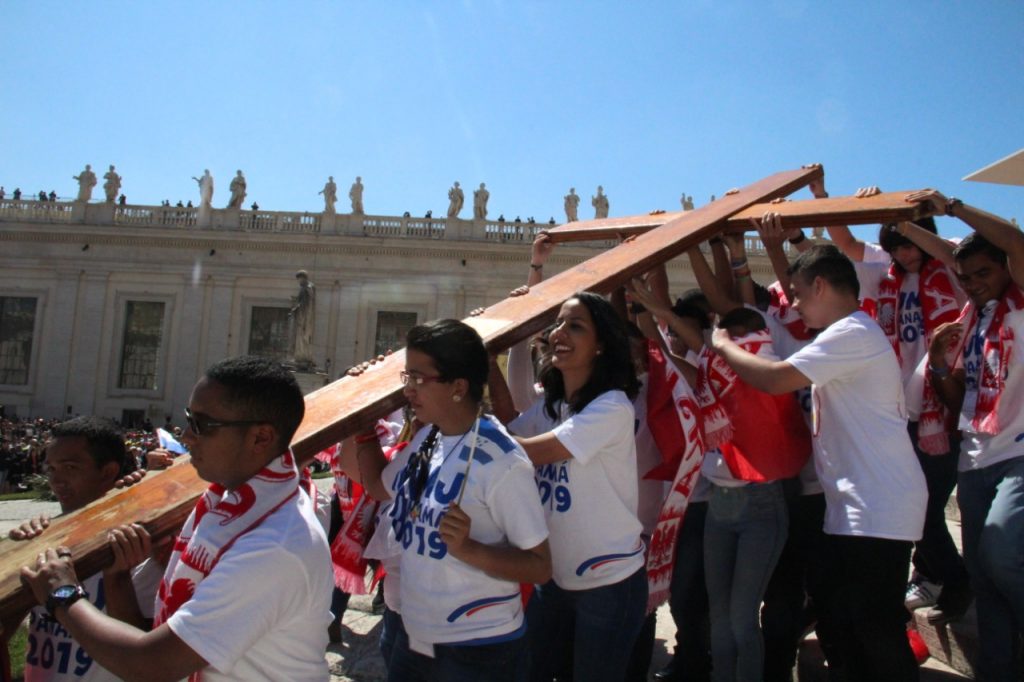
[3rd to experience the presence of the Risen Christ
To experience the presence of the risen Christ in our own lives, to encounter him “alive”, is the greatest spiritual joy, an explosion of light that can leave no one untouched. Mary sets out immediately, anxious to bring the news to others, to bear witness to the joy of this encounter. This too is what caused the haste of the first disciples following the resurrection: “[the women] left the tomb quickly with fear and great joy, and ran to tell his disciples” (Mt 28:8).
[4th To come out into the light and let ourselves be led by God]
The accounts of the resurrection, we often encounter two words: “awake” and “arise”. With them, the Lord pushes us to go out towards the light, to let him lead us across the threshold of all of our closed doors. “This image has great meaning for the Church. We too, as disciples of the Lord and the Christian community, are called to get up quickly, to enter into the mystery of the resurrection, and to let the Lord guide us along the paths that he wishes to point out to us” (Homily for the Solemnity of Saints Peter and Paul, 29 June 2022).
[5th Mary: Model of young people on the move, not those caught in the net]
The Mother of the Lord is a model for young people on the move, who refuse to stand in front of a mirror to contemplate themselves or to get caught up in the “net”. Mary’s focus is always directed outwards. She is the woman of Easter, in a permanent state of exodus, going forth from herself towards that great Other who is God and towards others, her brothers and sisters, especially those in greatest need, like her cousin Elizabeth.
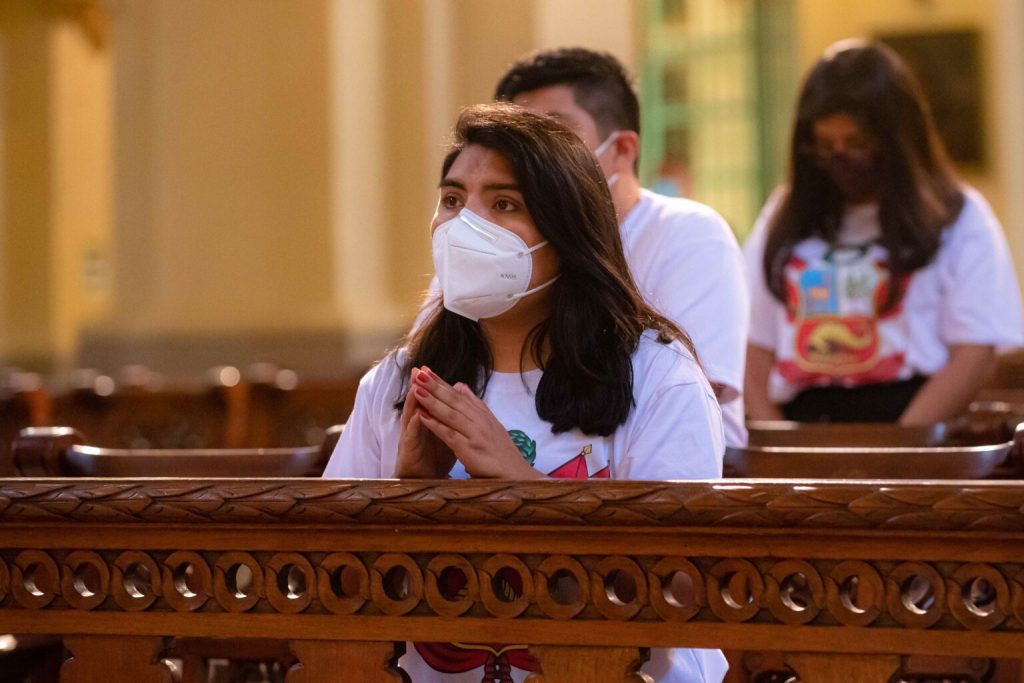
[6th . . . and She went with haste]
Saint Ambrose of Milan, in his commentary on the Gospel of Luke, writes that Mary set out in haste towards the hills, “because she rejoiced in the promise and sought to serve others with the enthusiasm born of her joy. Full of God, where else could she have gone if not towards the heights? The grace of the Holy Spirit permits no delay”. Mary’s haste is thus a sign of her desire to serve, to proclaim her joy, to respond without hesitation to the grace of the Holy Spirit.
Mary was motivated by the needs of her elderly cousin. She did not hold back, or remain indifferent. She thought more of others than of herself. And this gave enthusiasm and direction to her life. Each of you can ask: “How do I react to the needs that I see all around me? Do I think immediately of some reason not to get involved? Or do I show interest and willingness to help?” To be sure, you cannot resolve all the problems of the world. Yet you can begin with the problems of those closest to you, with the needs of your own community. Someone once told Mother Teresa: “What you are doing is a mere drop in the ocean”. And she replied: “But if I didn’t do it, that ocean would have one drop less”.
When faced with concrete and urgent needs, we need to act quickly. How many people in our world look forward to a visit from someone who is concerned about them! How many of the elderly, the sick, the imprisoned and refugees have need of a look of sympathy, a visit from a brother or sister who scales the walls of indifference!
[7th Young people: what kinds of haste do you have?]
What kinds of “haste” do you have, dear young people? What leads you to feel a need to get up and go, lest you end up standing still? Many people – in the wake of realities like the pandemic, war, forced migration, poverty, violence and climate disasters – are asking themselves: Why is this happening to me? Why me? And why now? But the real question in life is instead: for whom am I living? (cf. Christus Vivit, 286).
The haste of the young woman of Nazareth is the haste of those who have received extraordinary gifts from the Lord and feel compelled to share them, to let the immense grace that they have experienced be poured out upon others. It is the haste of those capable of putting other people’s needs above their own. Mary is an example of a young person who wastes no time on seeking attention or the approval of others – as often happens when we depend on our “likes” on social media. She sets out to find the most genuine of all “connections”: the one that comes from encounter, sharing, love and service.
[8th Mary continues visiting today]
Starting with the Annunciation, when she first set out to visit her cousin, Mary has never stopped bridging time and space to visit those of her sons and daughters who need her loving help. Our own journey, if “inhabited” by God, can lead us straight into the heart of every one of our brothers and sisters. How many testimonies have we heard from people who were “visited” by Mary, the Mother of Jesus and our Mother! In how many far-off places of the earth, in every age – through apparitions and special graces – has Mary visited her people! There is practically no place on earth that she has not visited. The Mother of God moves in the midst of her people by tender and loving care; she makes her own their anxieties and troubles. And wherever there is a shrine, a church or a chapel dedicated to Our Lady, there her children flock in great numbers. Think of all those expressions of popular piety! Pilgrimages, festivities, prayers, the enthronement of images in houses and so many other acts of devotion are concrete examples of a vital relationship between the Mother of the Lord and her people, who visit one another in turn!
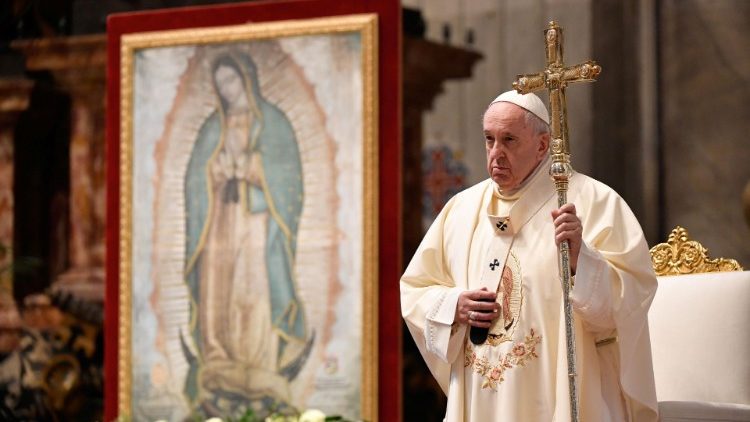
[9th Healthy haste and bad haste]
“Good” haste Healthy haste drives us always upwards and towards others
A healthy haste drives us always upwards and towards others. Yet there is also an unhealthy haste, which can drive us to live superficially and to take everything lightly. Without commitment or concern, without investing ourselves in what we do. It is the haste of those who live, study, work and socialize without any real personal investment. This can happen in interpersonal relationships. In families, when we never stop to listen and spend time with others. In friendships, when we expect our friends to keep us entertained and fulfil our needs, but immediately look the other way if we see that they are troubled and need our time and help. Even among couples in love, few have the patience to really get to know and understand each other. We can have the same attitude in school, at work and in other areas of our daily lives. When things are done in haste, they tend not to be fruitful. They risk remaining barren and lifeless. As we read in the book of Proverbs: “the plans of the diligent lead surely to abundance, but everyone who is hasty comes only to want” (21:5).
[10th The surprises of the Spirit come about when we show true hospitality]
When Mary arrives at the home of Zechariah and Elizabeth, a marvellous encounter takes place! Elizabeth herself had experienced miraculous intervention from God, who gave her a child in her old age. She would have had every reason to begin by talking about herself, yet she was not “full of herself”, but anxious to welcome her young cousin and the fruit of her womb. As soon as she heard Mary’s greeting, Elizabeth was filled with the Holy Spirit. Such surprises and outpourings of the Spirit come about when we show true hospitality, when we put others, not ourselves, at the centre. We see this too in the story of Zacchaeus. In the Gospel of Luke we read that “when Jesus came to the place [where Zacchaeus was], he looked up and said to him, ‘Zacchaeus, hurry and come down; for I must stay at your house today’. So he hurried down and was happy to welcome him” (19:5-6).
[11th Our own experience when Jesus came to meet us]
Many of us have had the unexpected experience of meeting Jesus and for the first time having a sense of closeness and respect, a lack of prejudice and disapproval, a loving gaze that we never encountered in any other. Not only that. We have also realized that, for Jesus, it was not enough to glimpse us from afar; he wanted to be with us and to share his life with us. The joy of this experience made us hasten to welcome him, to feel the need to be with him and to get to know him better. Elizabeth and Zechariah welcomed Mary and Jesus into their home. Let us learn from these two elderly persons the meaning of hospitality! Ask your parents and grandparents, and the oldest members of your communities, what it meant for them to have welcomed God and others into their lives. You will benefit from hearing the experiences of those who have gone before you.
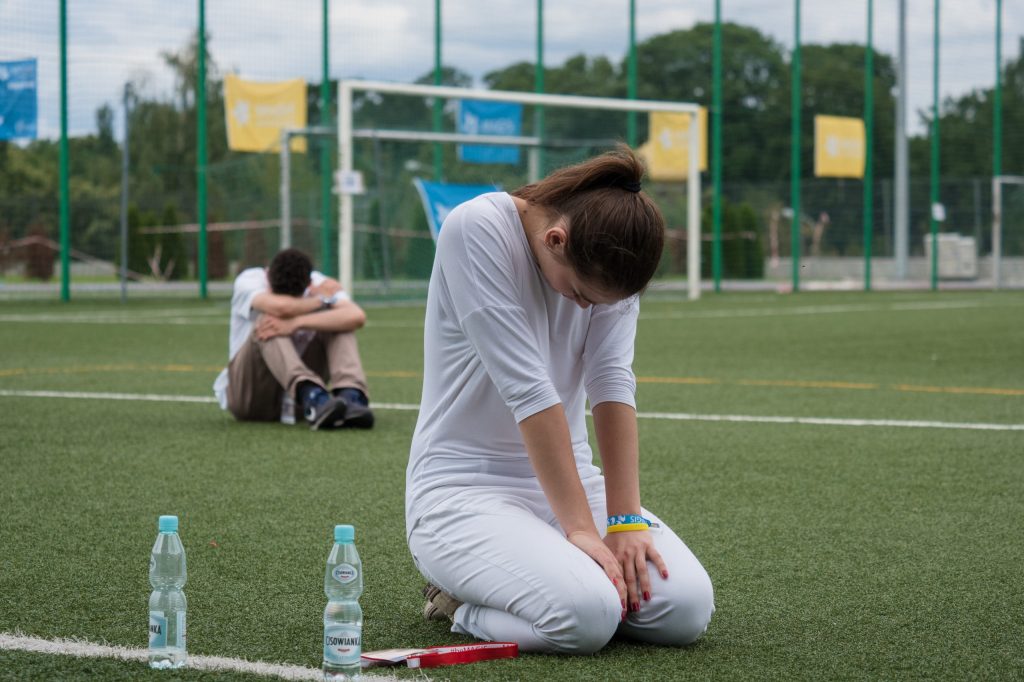
[12th Set out again towards concrete encounters]
Dear young people, now is the time to set out in haste towards concrete encounters, towards genuine acceptance of those different from ourselves. This was the case with the young Mary and the elderly Elizabeth. Only thus will we bridge distances – between generations, social classes, ethnic and other groups – and even put an end to wars. Young people always represent the hope for new unity within our fragmented and divided human family. But only if they can preserve memory, only if they can hear the dramas and dreams of the elderly. “It is no coincidence that war is returning to Europe at a time when the generation that experienced it in the last century is dying out” (Message for the 2022 World Day for Grandparents and the Elderly). We need the covenant between young and old, lest we forget the lessons of history; we need to overcome all the forms of polarization and extremism present in today’s world.
[13th The greatest gift is to bring Jesus]
Saint Paul, writing to the Ephesians, announced that, “now in Christ Jesus, you who once were far off have been brought near by the blood of Christ. For he is our peace; in his flesh he has made both groups into one and has broken down the dividing wall, that is, the hostility between us” (2:13-14). Jesus is God’s response to the challenges facing humanity in every age. Mary carries that response within her when she goes to visit Elizabeth. The greatest gift that Mary brings to her elderly kinswoman is that of Jesus himself. Certainly, the concrete assistance she offered was most valuable. Yet nothing could have filled the house of Zechariah with such great joy and satisfaction as the presence of Jesus in the womb of the Virgin, now a tabernacle of the living God. In that mountain village, Jesus, by his mere presence and without uttering a word, preached his first “Sermon on the Mount”. He silently proclaimed the beatitude of the poor and the meek who trust in God’s mercy.
My message for you, dear young people, the great message entrusted to the Church, is Jesus! Yes, Jesus himself, in his infinite love for each of us, his salvation and the new life he has bestowed upon us. Mary is our model; she shows us how to welcome this immense gift into our lives, to share it with others, and thus to bring Christ, his compassionate love and his generous service to our deeply wounded humanity.
[14th All together to Lisbon!]
Mary was a young woman, like many of you. She was one of us. An Italian Bishop, Don Tonino Bello, addressed this prayer to her: “Holy Mary…, we know very well that you were destined to sail the ocean deep. If we beg you to hug the coast, it is not because we want to hold you back, but because, seeing your closeness to the shores of our discouragement, we come to see that we too are called to venture out, as you did, upon the high seas of freedom” (Maria, donna dei nostri giorni, Cinisello Balsamo, 2012, 12-13).
It was from Portugal, as I mentioned in the first Message of this trilogy, that in the fifteenth and sixteenth centuries great numbers of young people – including many missionaries – set out for worlds unknown, not least to share their experience of Jesus with other peoples and nations (cf. Message for the 2020 World Youth Day). To that land, at the dawn of the twentieth century, Mary chose to make a special visit. From Fatima, she addressed to people of all ages the powerful and magnificent message of God’s love, which summons us to conversion and to true freedom. Once more, I invite each of you to take part in the great intercontinental pilgrimage of young people that will culminate in the celebration of World Youth Day in Lisbon next August. I also want to remind you that next 20 November, the Solemnity of Christ the King, we will celebrate World Youth Day in local Churches throughout the world. In this regard, the recent document of the Dicastery for the Laity, the Family and Life – Pastoral Guidelines for the Celebration of World Youth Day in the Particular Churches – can be of great help to all those engaged in the pastoral care of young people.
Dear young people, it is my dream that at World Youth Day you will be able to experience anew the joy of encountering God and our brothers and sisters. After a long period of social distancing and isolation, we will all rediscover in Lisbon – with God’s help – the joy of a fraternal embrace between peoples and generations, an embrace of reconciliation and peace, an embrace of new missionary fraternity! May the Holy Spirit kindle in your hearts a desire to “arise” and the joy of journeying together, in synodal fashion, leaving behind all false frontiers. Now is the time to arise! Like Mary, let us “arise and go in haste”. Let us carry Jesus within our hearts, and bring him to all those whom we meet! In this beautiful season of your lives, press ahead and do not postpone all the good that the Holy Spirit can accomplish in you! With affection, I bless your dreams and every step of your journey.
Rome, Saint John Lateran, 15 August 2022,
Solemnity of the Assumption of the Blessed Virgin Mary
Franciscus


